Marketing Strategy Report: Pizza Hut, Consumer Behavior and Strategy
VerifiedAdded on 2023/01/11
|20
|4772
|56
Report
AI Summary
This report provides a comprehensive analysis of Pizza Hut's marketing strategy, examining various aspects of its operations and consumer behavior. The report begins with an executive summary and an introduction to Pizza Hut, detailing its history and global presence. It then delves into market segmentation, including geographic, demographic, psychographic, and behavioral segmentation, to understand Pizza Hut's target market. A market analysis of the New Zealand restaurant market is conducted, considering factors such as location, age, social class, and education. The report also explores promotional strategies, advertisement techniques, and market trends. It analyzes consumer buying habits, identifying internal factors such as perception, attitude, personal needs, and motives, as well as external factors like culture, social class, and reference groups. The report further discusses Pizza Hut's marketing strategies, including place, distribution, promotion, product lifecycle, and pricing. It concludes with an ethical communication slogan and a summary of the findings.
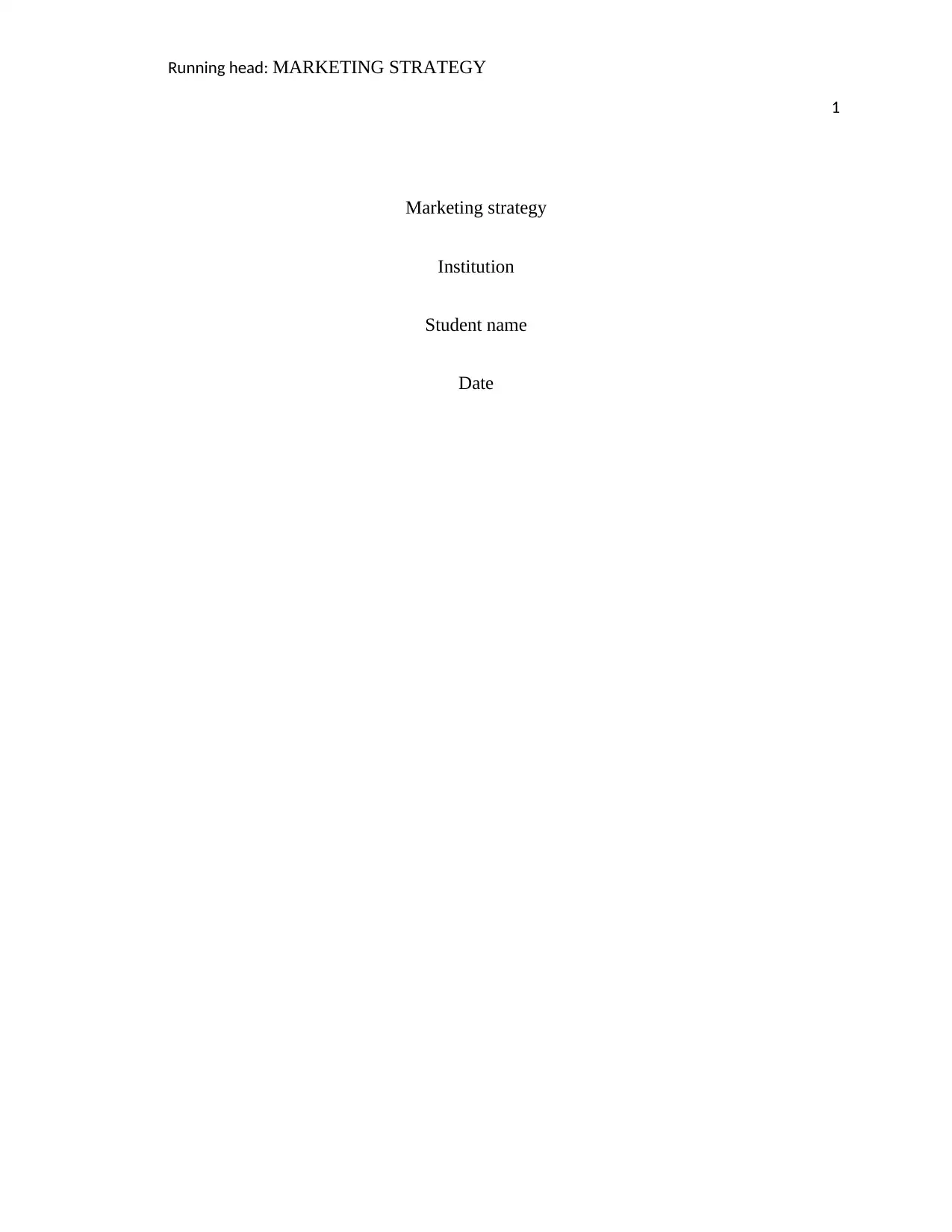
Running head: MARKETING STRATEGY
1
Marketing strategy
Institution
Student name
Date
1
Marketing strategy
Institution
Student name
Date
Paraphrase This Document
Need a fresh take? Get an instant paraphrase of this document with our AI Paraphraser
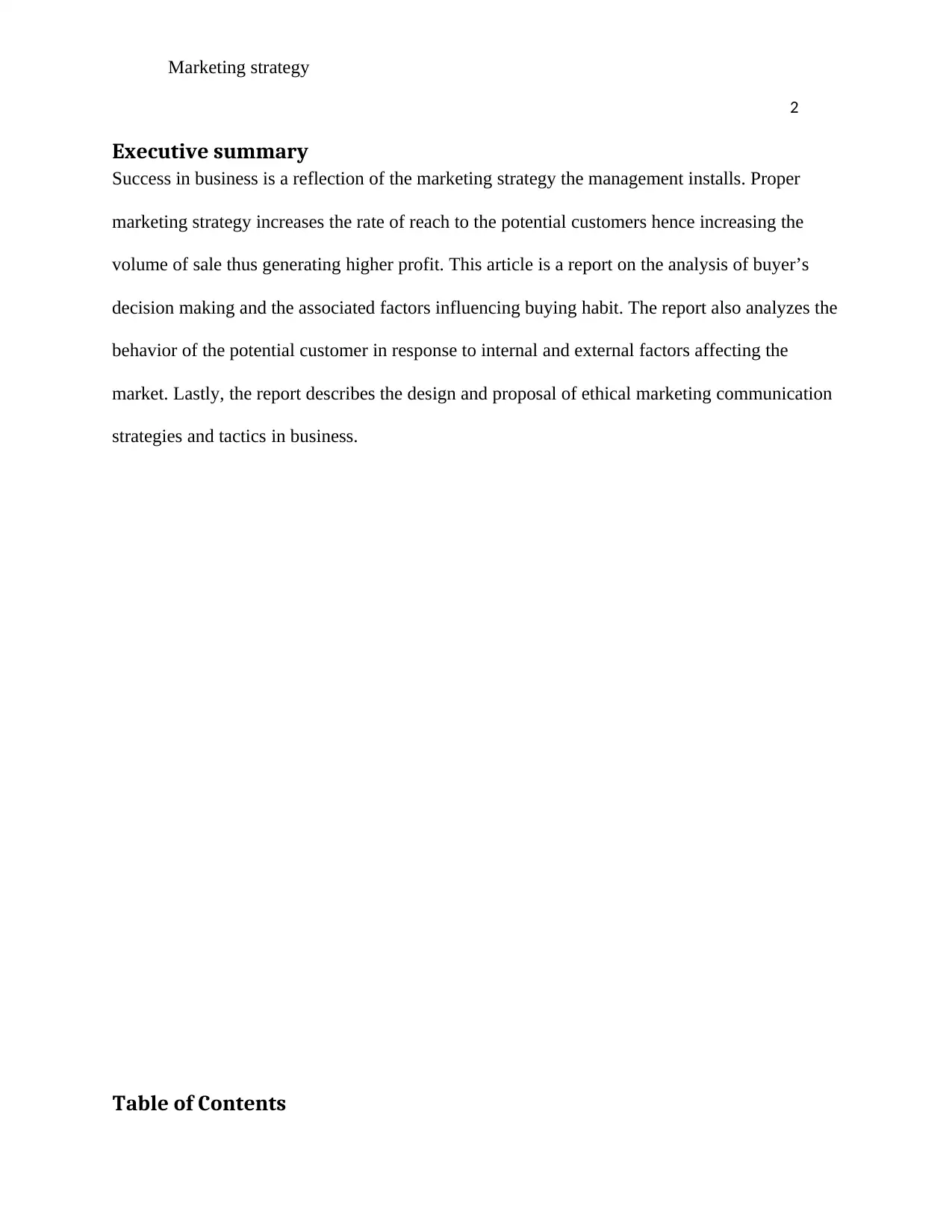
Marketing strategy
2
Executive summary
Success in business is a reflection of the marketing strategy the management installs. Proper
marketing strategy increases the rate of reach to the potential customers hence increasing the
volume of sale thus generating higher profit. This article is a report on the analysis of buyer’s
decision making and the associated factors influencing buying habit. The report also analyzes the
behavior of the potential customer in response to internal and external factors affecting the
market. Lastly, the report describes the design and proposal of ethical marketing communication
strategies and tactics in business.
Table of Contents
2
Executive summary
Success in business is a reflection of the marketing strategy the management installs. Proper
marketing strategy increases the rate of reach to the potential customers hence increasing the
volume of sale thus generating higher profit. This article is a report on the analysis of buyer’s
decision making and the associated factors influencing buying habit. The report also analyzes the
behavior of the potential customer in response to internal and external factors affecting the
market. Lastly, the report describes the design and proposal of ethical marketing communication
strategies and tactics in business.
Table of Contents
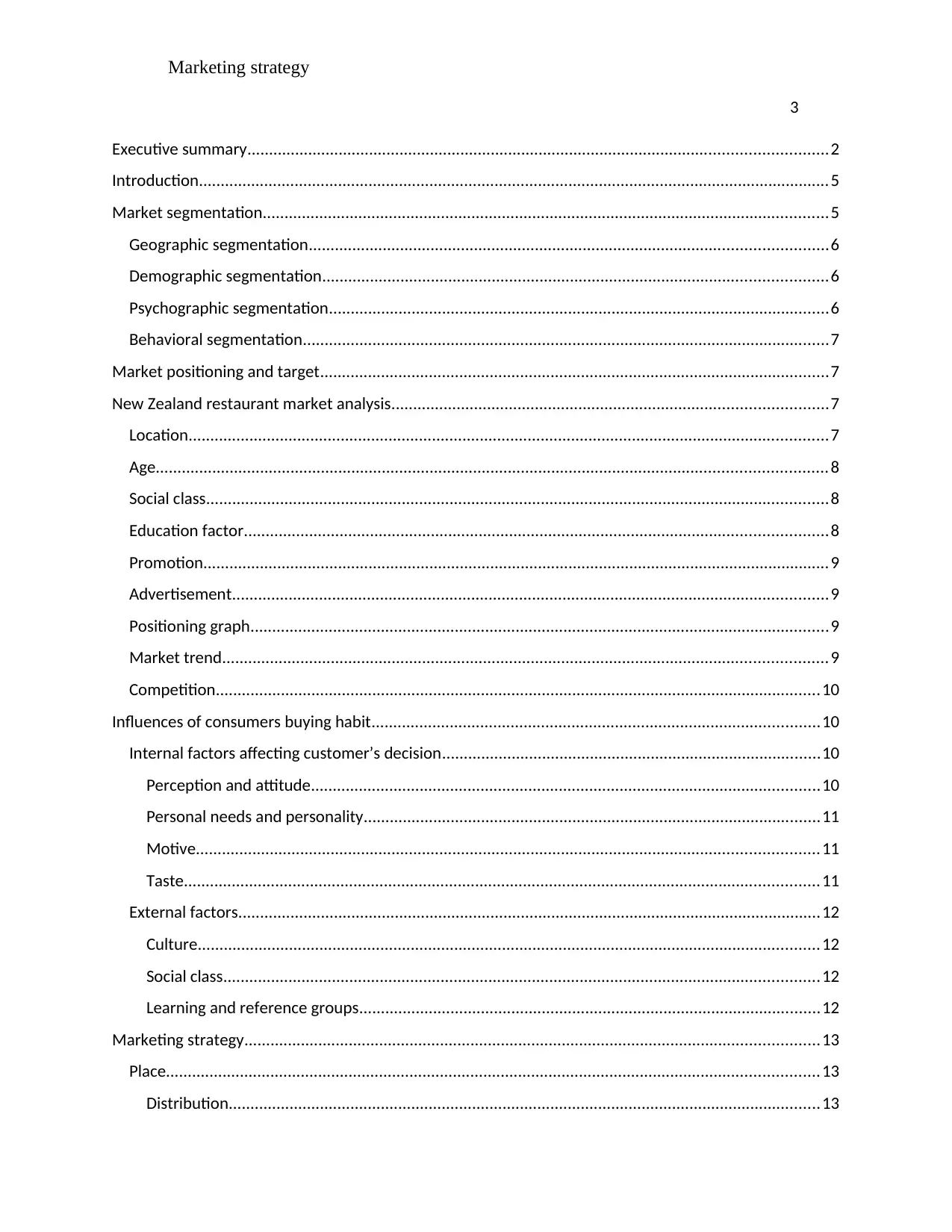
Marketing strategy
3
Executive summary.....................................................................................................................................2
Introduction.................................................................................................................................................5
Market segmentation..................................................................................................................................5
Geographic segmentation.......................................................................................................................6
Demographic segmentation....................................................................................................................6
Psychographic segmentation...................................................................................................................6
Behavioral segmentation.........................................................................................................................7
Market positioning and target.....................................................................................................................7
New Zealand restaurant market analysis....................................................................................................7
Location...................................................................................................................................................7
Age..........................................................................................................................................................8
Social class...............................................................................................................................................8
Education factor......................................................................................................................................8
Promotion................................................................................................................................................9
Advertisement.........................................................................................................................................9
Positioning graph.....................................................................................................................................9
Market trend...........................................................................................................................................9
Competition...........................................................................................................................................10
Influences of consumers buying habit.......................................................................................................10
Internal factors affecting customer’s decision.......................................................................................10
Perception and attitude.....................................................................................................................10
Personal needs and personality.........................................................................................................11
Motive...............................................................................................................................................11
Taste..................................................................................................................................................11
External factors......................................................................................................................................12
Culture...............................................................................................................................................12
Social class.........................................................................................................................................12
Learning and reference groups..........................................................................................................12
Marketing strategy....................................................................................................................................13
Place......................................................................................................................................................13
Distribution........................................................................................................................................13
3
Executive summary.....................................................................................................................................2
Introduction.................................................................................................................................................5
Market segmentation..................................................................................................................................5
Geographic segmentation.......................................................................................................................6
Demographic segmentation....................................................................................................................6
Psychographic segmentation...................................................................................................................6
Behavioral segmentation.........................................................................................................................7
Market positioning and target.....................................................................................................................7
New Zealand restaurant market analysis....................................................................................................7
Location...................................................................................................................................................7
Age..........................................................................................................................................................8
Social class...............................................................................................................................................8
Education factor......................................................................................................................................8
Promotion................................................................................................................................................9
Advertisement.........................................................................................................................................9
Positioning graph.....................................................................................................................................9
Market trend...........................................................................................................................................9
Competition...........................................................................................................................................10
Influences of consumers buying habit.......................................................................................................10
Internal factors affecting customer’s decision.......................................................................................10
Perception and attitude.....................................................................................................................10
Personal needs and personality.........................................................................................................11
Motive...............................................................................................................................................11
Taste..................................................................................................................................................11
External factors......................................................................................................................................12
Culture...............................................................................................................................................12
Social class.........................................................................................................................................12
Learning and reference groups..........................................................................................................12
Marketing strategy....................................................................................................................................13
Place......................................................................................................................................................13
Distribution........................................................................................................................................13
⊘ This is a preview!⊘
Do you want full access?
Subscribe today to unlock all pages.

Trusted by 1+ million students worldwide
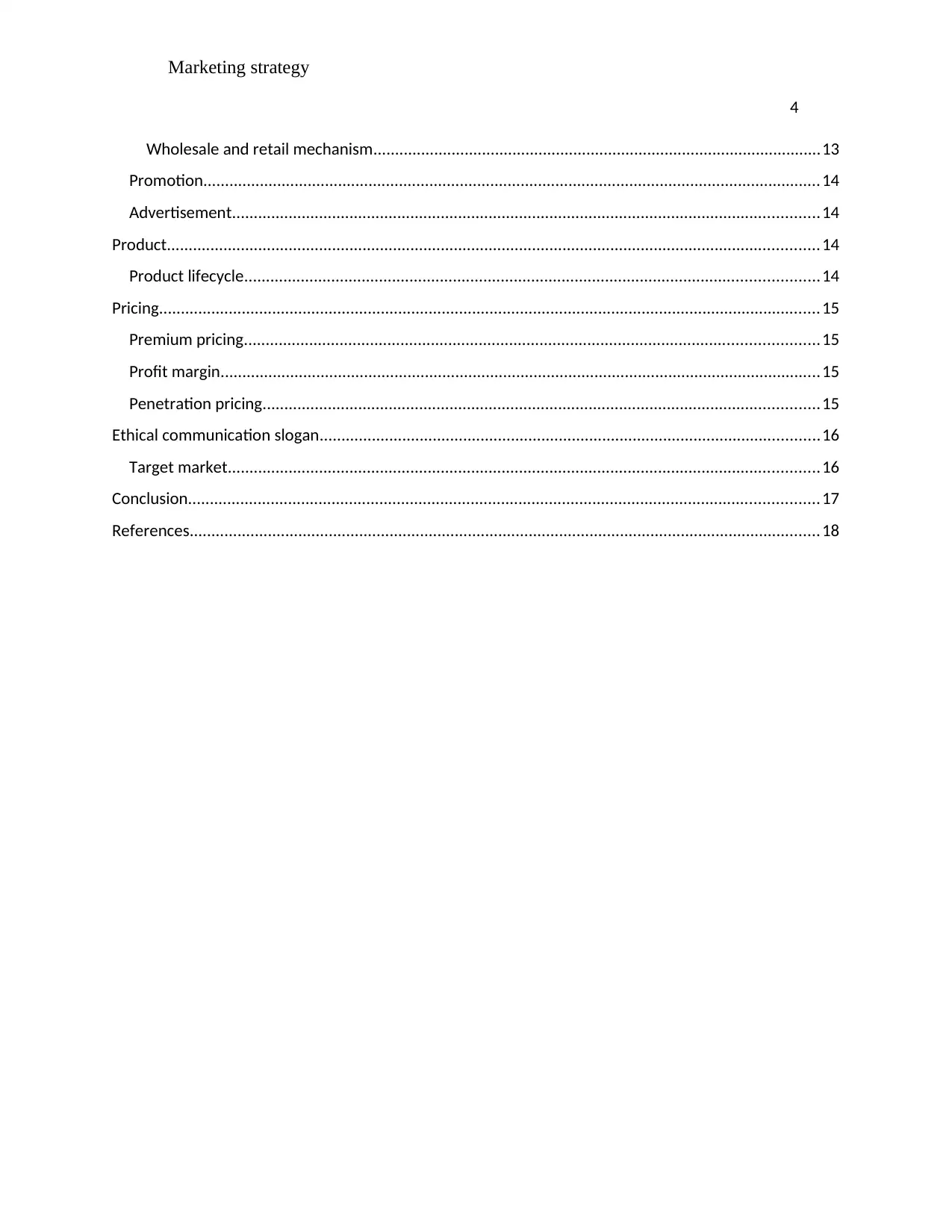
Marketing strategy
4
Wholesale and retail mechanism.......................................................................................................13
Promotion..............................................................................................................................................14
Advertisement.......................................................................................................................................14
Product......................................................................................................................................................14
Product lifecycle....................................................................................................................................14
Pricing........................................................................................................................................................15
Premium pricing....................................................................................................................................15
Profit margin..........................................................................................................................................15
Penetration pricing................................................................................................................................15
Ethical communication slogan...................................................................................................................16
Target market........................................................................................................................................16
Conclusion.................................................................................................................................................17
References.................................................................................................................................................18
4
Wholesale and retail mechanism.......................................................................................................13
Promotion..............................................................................................................................................14
Advertisement.......................................................................................................................................14
Product......................................................................................................................................................14
Product lifecycle....................................................................................................................................14
Pricing........................................................................................................................................................15
Premium pricing....................................................................................................................................15
Profit margin..........................................................................................................................................15
Penetration pricing................................................................................................................................15
Ethical communication slogan...................................................................................................................16
Target market........................................................................................................................................16
Conclusion.................................................................................................................................................17
References.................................................................................................................................................18
Paraphrase This Document
Need a fresh take? Get an instant paraphrase of this document with our AI Paraphraser
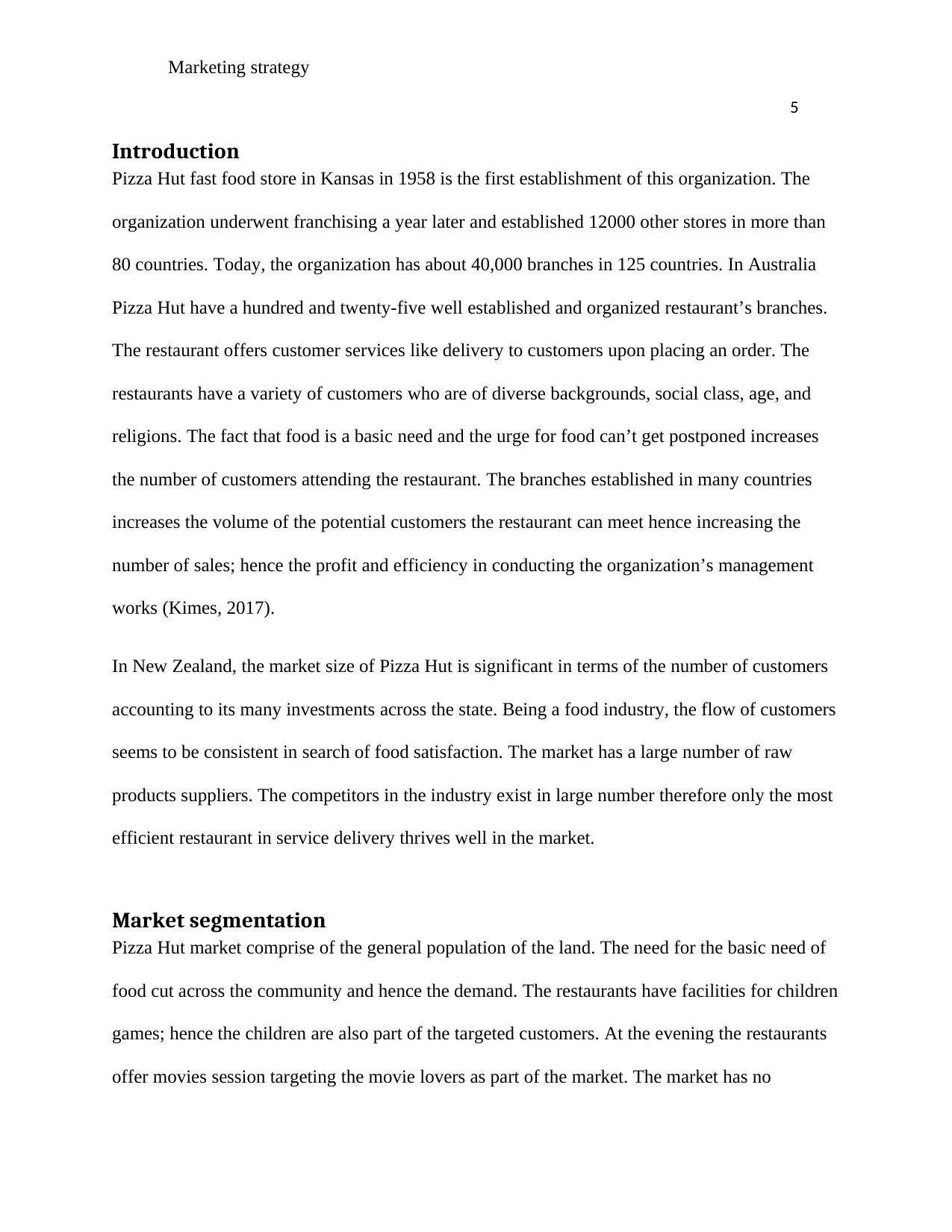
Marketing strategy
5
Introduction
Pizza Hut fast food store in Kansas in 1958 is the first establishment of this organization. The
organization underwent franchising a year later and established 12000 other stores in more than
80 countries. Today, the organization has about 40,000 branches in 125 countries. In Australia
Pizza Hut have a hundred and twenty-five well established and organized restaurant’s branches.
The restaurant offers customer services like delivery to customers upon placing an order. The
restaurants have a variety of customers who are of diverse backgrounds, social class, age, and
religions. The fact that food is a basic need and the urge for food can’t get postponed increases
the number of customers attending the restaurant. The branches established in many countries
increases the volume of the potential customers the restaurant can meet hence increasing the
number of sales; hence the profit and efficiency in conducting the organization’s management
works (Kimes, 2017).
In New Zealand, the market size of Pizza Hut is significant in terms of the number of customers
accounting to its many investments across the state. Being a food industry, the flow of customers
seems to be consistent in search of food satisfaction. The market has a large number of raw
products suppliers. The competitors in the industry exist in large number therefore only the most
efficient restaurant in service delivery thrives well in the market.
Market segmentation
Pizza Hut market comprise of the general population of the land. The need for the basic need of
food cut across the community and hence the demand. The restaurants have facilities for children
games; hence the children are also part of the targeted customers. At the evening the restaurants
offer movies session targeting the movie lovers as part of the market. The market has no
5
Introduction
Pizza Hut fast food store in Kansas in 1958 is the first establishment of this organization. The
organization underwent franchising a year later and established 12000 other stores in more than
80 countries. Today, the organization has about 40,000 branches in 125 countries. In Australia
Pizza Hut have a hundred and twenty-five well established and organized restaurant’s branches.
The restaurant offers customer services like delivery to customers upon placing an order. The
restaurants have a variety of customers who are of diverse backgrounds, social class, age, and
religions. The fact that food is a basic need and the urge for food can’t get postponed increases
the number of customers attending the restaurant. The branches established in many countries
increases the volume of the potential customers the restaurant can meet hence increasing the
number of sales; hence the profit and efficiency in conducting the organization’s management
works (Kimes, 2017).
In New Zealand, the market size of Pizza Hut is significant in terms of the number of customers
accounting to its many investments across the state. Being a food industry, the flow of customers
seems to be consistent in search of food satisfaction. The market has a large number of raw
products suppliers. The competitors in the industry exist in large number therefore only the most
efficient restaurant in service delivery thrives well in the market.
Market segmentation
Pizza Hut market comprise of the general population of the land. The need for the basic need of
food cut across the community and hence the demand. The restaurants have facilities for children
games; hence the children are also part of the targeted customers. At the evening the restaurants
offer movies session targeting the movie lovers as part of the market. The market has no
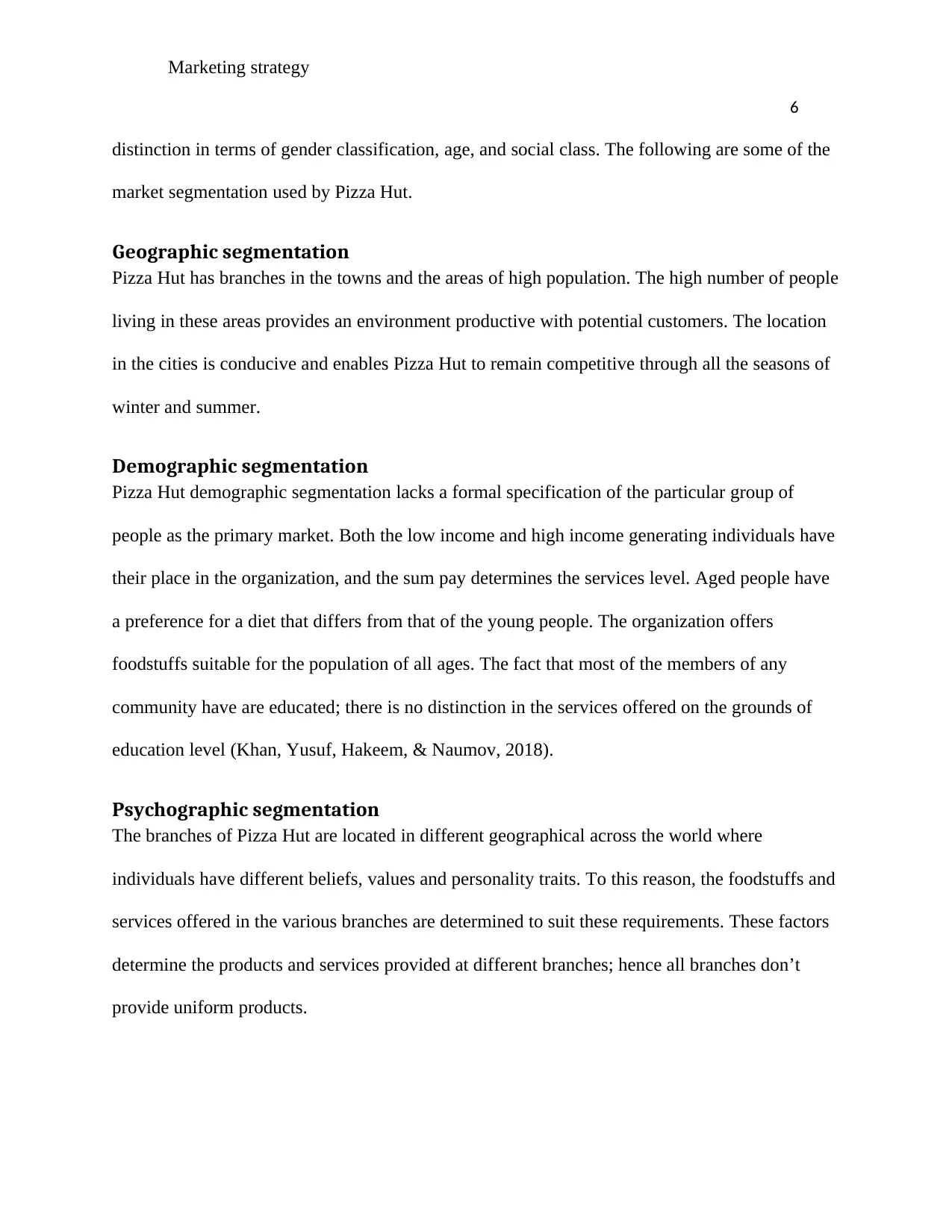
Marketing strategy
6
distinction in terms of gender classification, age, and social class. The following are some of the
market segmentation used by Pizza Hut.
Geographic segmentation
Pizza Hut has branches in the towns and the areas of high population. The high number of people
living in these areas provides an environment productive with potential customers. The location
in the cities is conducive and enables Pizza Hut to remain competitive through all the seasons of
winter and summer.
Demographic segmentation
Pizza Hut demographic segmentation lacks a formal specification of the particular group of
people as the primary market. Both the low income and high income generating individuals have
their place in the organization, and the sum pay determines the services level. Aged people have
a preference for a diet that differs from that of the young people. The organization offers
foodstuffs suitable for the population of all ages. The fact that most of the members of any
community have are educated; there is no distinction in the services offered on the grounds of
education level (Khan, Yusuf, Hakeem, & Naumov, 2018).
Psychographic segmentation
The branches of Pizza Hut are located in different geographical across the world where
individuals have different beliefs, values and personality traits. To this reason, the foodstuffs and
services offered in the various branches are determined to suit these requirements. These factors
determine the products and services provided at different branches; hence all branches don’t
provide uniform products.
6
distinction in terms of gender classification, age, and social class. The following are some of the
market segmentation used by Pizza Hut.
Geographic segmentation
Pizza Hut has branches in the towns and the areas of high population. The high number of people
living in these areas provides an environment productive with potential customers. The location
in the cities is conducive and enables Pizza Hut to remain competitive through all the seasons of
winter and summer.
Demographic segmentation
Pizza Hut demographic segmentation lacks a formal specification of the particular group of
people as the primary market. Both the low income and high income generating individuals have
their place in the organization, and the sum pay determines the services level. Aged people have
a preference for a diet that differs from that of the young people. The organization offers
foodstuffs suitable for the population of all ages. The fact that most of the members of any
community have are educated; there is no distinction in the services offered on the grounds of
education level (Khan, Yusuf, Hakeem, & Naumov, 2018).
Psychographic segmentation
The branches of Pizza Hut are located in different geographical across the world where
individuals have different beliefs, values and personality traits. To this reason, the foodstuffs and
services offered in the various branches are determined to suit these requirements. These factors
determine the products and services provided at different branches; hence all branches don’t
provide uniform products.
⊘ This is a preview!⊘
Do you want full access?
Subscribe today to unlock all pages.

Trusted by 1+ million students worldwide
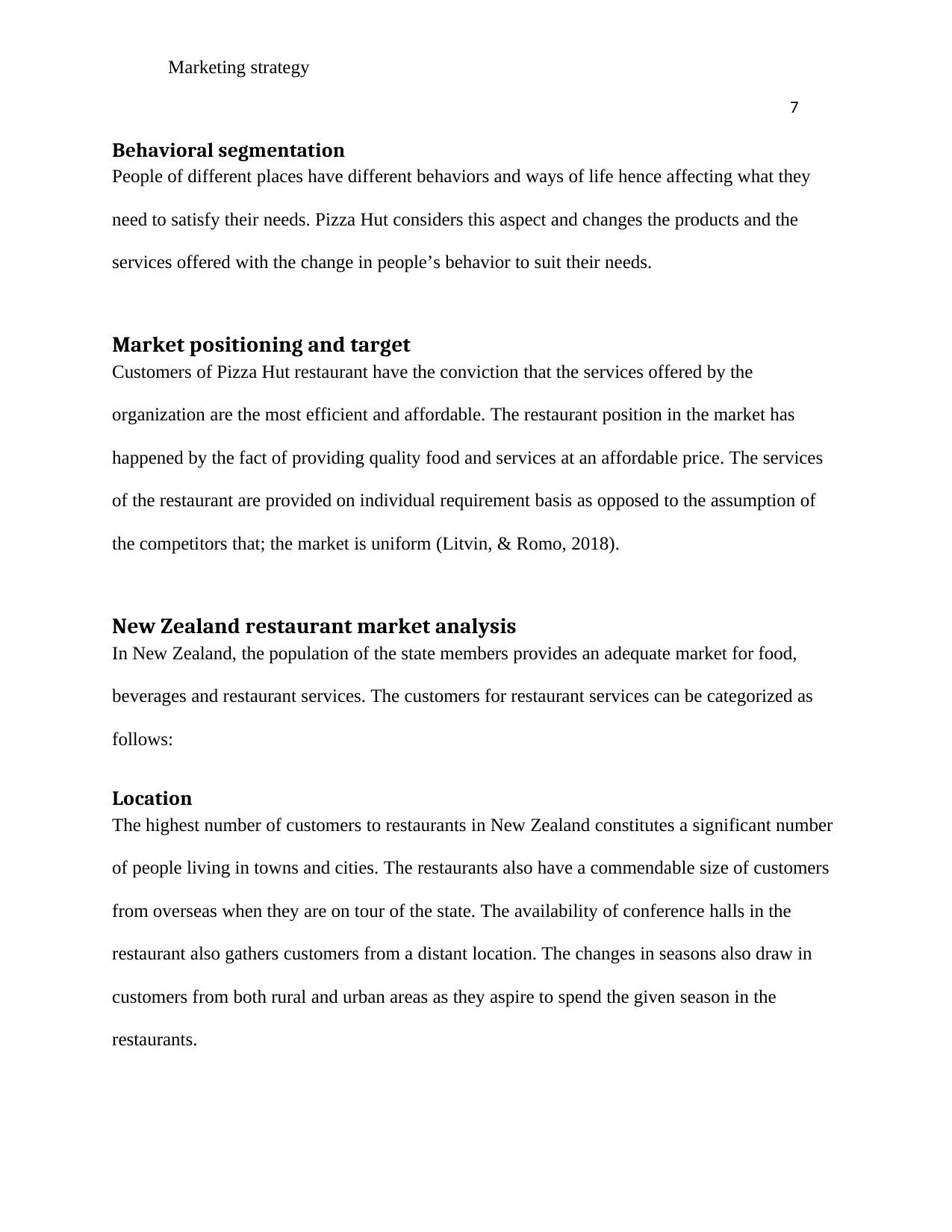
Marketing strategy
7
Behavioral segmentation
People of different places have different behaviors and ways of life hence affecting what they
need to satisfy their needs. Pizza Hut considers this aspect and changes the products and the
services offered with the change in people’s behavior to suit their needs.
Market positioning and target
Customers of Pizza Hut restaurant have the conviction that the services offered by the
organization are the most efficient and affordable. The restaurant position in the market has
happened by the fact of providing quality food and services at an affordable price. The services
of the restaurant are provided on individual requirement basis as opposed to the assumption of
the competitors that; the market is uniform (Litvin, & Romo, 2018).
New Zealand restaurant market analysis
In New Zealand, the population of the state members provides an adequate market for food,
beverages and restaurant services. The customers for restaurant services can be categorized as
follows:
Location
The highest number of customers to restaurants in New Zealand constitutes a significant number
of people living in towns and cities. The restaurants also have a commendable size of customers
from overseas when they are on tour of the state. The availability of conference halls in the
restaurant also gathers customers from a distant location. The changes in seasons also draw in
customers from both rural and urban areas as they aspire to spend the given season in the
restaurants.
7
Behavioral segmentation
People of different places have different behaviors and ways of life hence affecting what they
need to satisfy their needs. Pizza Hut considers this aspect and changes the products and the
services offered with the change in people’s behavior to suit their needs.
Market positioning and target
Customers of Pizza Hut restaurant have the conviction that the services offered by the
organization are the most efficient and affordable. The restaurant position in the market has
happened by the fact of providing quality food and services at an affordable price. The services
of the restaurant are provided on individual requirement basis as opposed to the assumption of
the competitors that; the market is uniform (Litvin, & Romo, 2018).
New Zealand restaurant market analysis
In New Zealand, the population of the state members provides an adequate market for food,
beverages and restaurant services. The customers for restaurant services can be categorized as
follows:
Location
The highest number of customers to restaurants in New Zealand constitutes a significant number
of people living in towns and cities. The restaurants also have a commendable size of customers
from overseas when they are on tour of the state. The availability of conference halls in the
restaurant also gathers customers from a distant location. The changes in seasons also draw in
customers from both rural and urban areas as they aspire to spend the given season in the
restaurants.
Paraphrase This Document
Need a fresh take? Get an instant paraphrase of this document with our AI Paraphraser
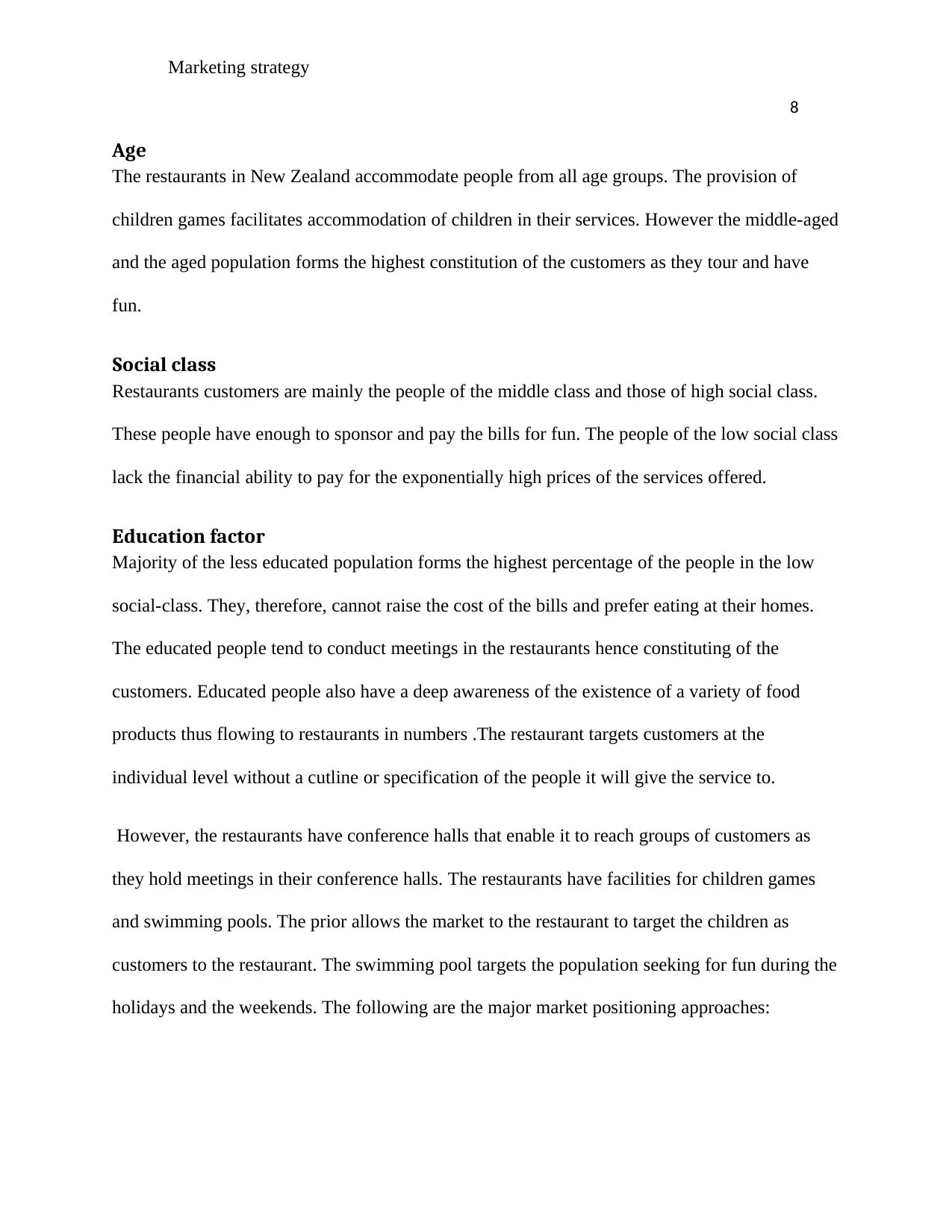
Marketing strategy
8
Age
The restaurants in New Zealand accommodate people from all age groups. The provision of
children games facilitates accommodation of children in their services. However the middle-aged
and the aged population forms the highest constitution of the customers as they tour and have
fun.
Social class
Restaurants customers are mainly the people of the middle class and those of high social class.
These people have enough to sponsor and pay the bills for fun. The people of the low social class
lack the financial ability to pay for the exponentially high prices of the services offered.
Education factor
Majority of the less educated population forms the highest percentage of the people in the low
social-class. They, therefore, cannot raise the cost of the bills and prefer eating at their homes.
The educated people tend to conduct meetings in the restaurants hence constituting of the
customers. Educated people also have a deep awareness of the existence of a variety of food
products thus flowing to restaurants in numbers .The restaurant targets customers at the
individual level without a cutline or specification of the people it will give the service to.
However, the restaurants have conference halls that enable it to reach groups of customers as
they hold meetings in their conference halls. The restaurants have facilities for children games
and swimming pools. The prior allows the market to the restaurant to target the children as
customers to the restaurant. The swimming pool targets the population seeking for fun during the
holidays and the weekends. The following are the major market positioning approaches:
8
Age
The restaurants in New Zealand accommodate people from all age groups. The provision of
children games facilitates accommodation of children in their services. However the middle-aged
and the aged population forms the highest constitution of the customers as they tour and have
fun.
Social class
Restaurants customers are mainly the people of the middle class and those of high social class.
These people have enough to sponsor and pay the bills for fun. The people of the low social class
lack the financial ability to pay for the exponentially high prices of the services offered.
Education factor
Majority of the less educated population forms the highest percentage of the people in the low
social-class. They, therefore, cannot raise the cost of the bills and prefer eating at their homes.
The educated people tend to conduct meetings in the restaurants hence constituting of the
customers. Educated people also have a deep awareness of the existence of a variety of food
products thus flowing to restaurants in numbers .The restaurant targets customers at the
individual level without a cutline or specification of the people it will give the service to.
However, the restaurants have conference halls that enable it to reach groups of customers as
they hold meetings in their conference halls. The restaurants have facilities for children games
and swimming pools. The prior allows the market to the restaurant to target the children as
customers to the restaurant. The swimming pool targets the population seeking for fun during the
holidays and the weekends. The following are the major market positioning approaches:
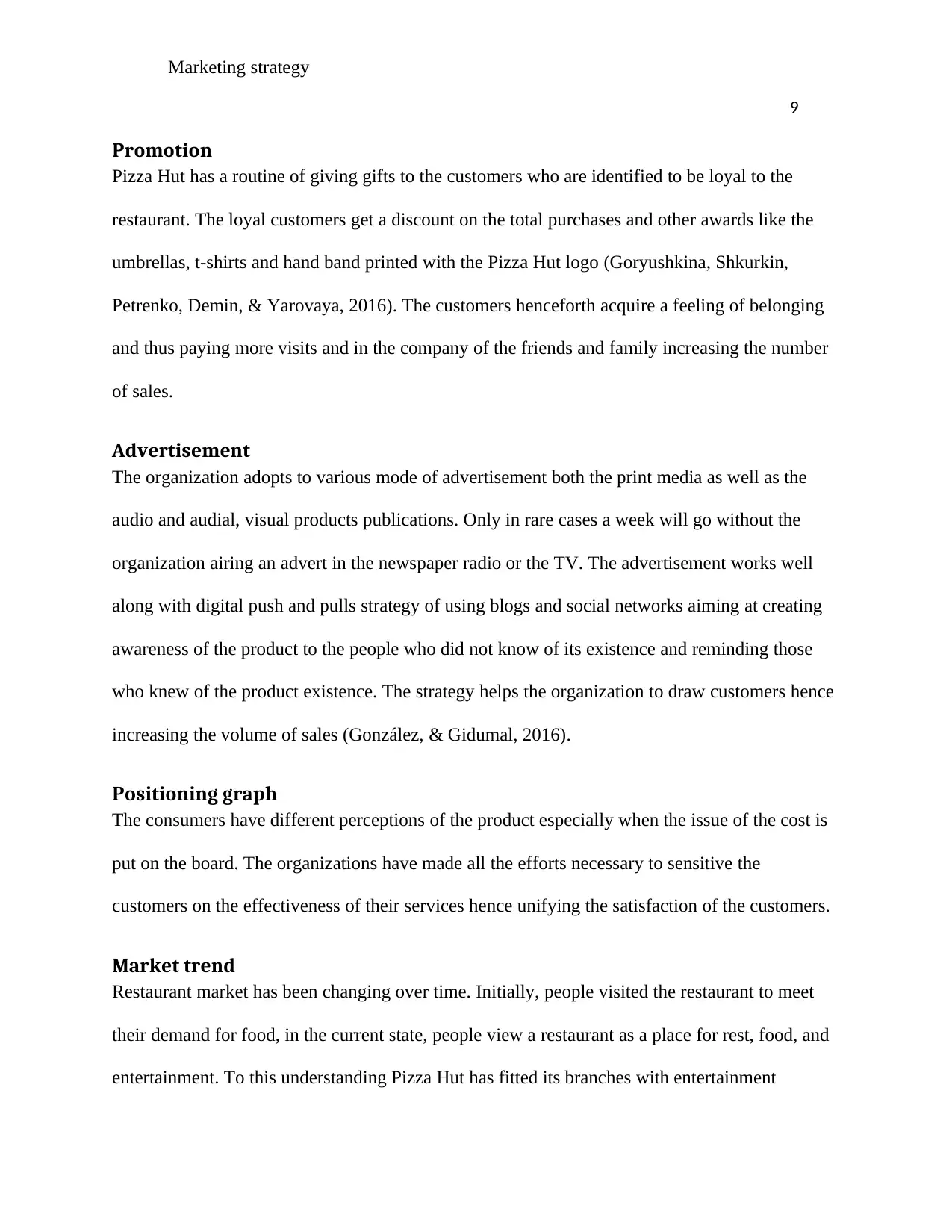
Marketing strategy
9
Promotion
Pizza Hut has a routine of giving gifts to the customers who are identified to be loyal to the
restaurant. The loyal customers get a discount on the total purchases and other awards like the
umbrellas, t-shirts and hand band printed with the Pizza Hut logo (Goryushkina, Shkurkin,
Petrenko, Demin, & Yarovaya, 2016). The customers henceforth acquire a feeling of belonging
and thus paying more visits and in the company of the friends and family increasing the number
of sales.
Advertisement
The organization adopts to various mode of advertisement both the print media as well as the
audio and audial, visual products publications. Only in rare cases a week will go without the
organization airing an advert in the newspaper radio or the TV. The advertisement works well
along with digital push and pulls strategy of using blogs and social networks aiming at creating
awareness of the product to the people who did not know of its existence and reminding those
who knew of the product existence. The strategy helps the organization to draw customers hence
increasing the volume of sales (González, & Gidumal, 2016).
Positioning graph
The consumers have different perceptions of the product especially when the issue of the cost is
put on the board. The organizations have made all the efforts necessary to sensitive the
customers on the effectiveness of their services hence unifying the satisfaction of the customers.
Market trend
Restaurant market has been changing over time. Initially, people visited the restaurant to meet
their demand for food, in the current state, people view a restaurant as a place for rest, food, and
entertainment. To this understanding Pizza Hut has fitted its branches with entertainment
9
Promotion
Pizza Hut has a routine of giving gifts to the customers who are identified to be loyal to the
restaurant. The loyal customers get a discount on the total purchases and other awards like the
umbrellas, t-shirts and hand band printed with the Pizza Hut logo (Goryushkina, Shkurkin,
Petrenko, Demin, & Yarovaya, 2016). The customers henceforth acquire a feeling of belonging
and thus paying more visits and in the company of the friends and family increasing the number
of sales.
Advertisement
The organization adopts to various mode of advertisement both the print media as well as the
audio and audial, visual products publications. Only in rare cases a week will go without the
organization airing an advert in the newspaper radio or the TV. The advertisement works well
along with digital push and pulls strategy of using blogs and social networks aiming at creating
awareness of the product to the people who did not know of its existence and reminding those
who knew of the product existence. The strategy helps the organization to draw customers hence
increasing the volume of sales (González, & Gidumal, 2016).
Positioning graph
The consumers have different perceptions of the product especially when the issue of the cost is
put on the board. The organizations have made all the efforts necessary to sensitive the
customers on the effectiveness of their services hence unifying the satisfaction of the customers.
Market trend
Restaurant market has been changing over time. Initially, people visited the restaurant to meet
their demand for food, in the current state, people view a restaurant as a place for rest, food, and
entertainment. To this understanding Pizza Hut has fitted its branches with entertainment
⊘ This is a preview!⊘
Do you want full access?
Subscribe today to unlock all pages.

Trusted by 1+ million students worldwide
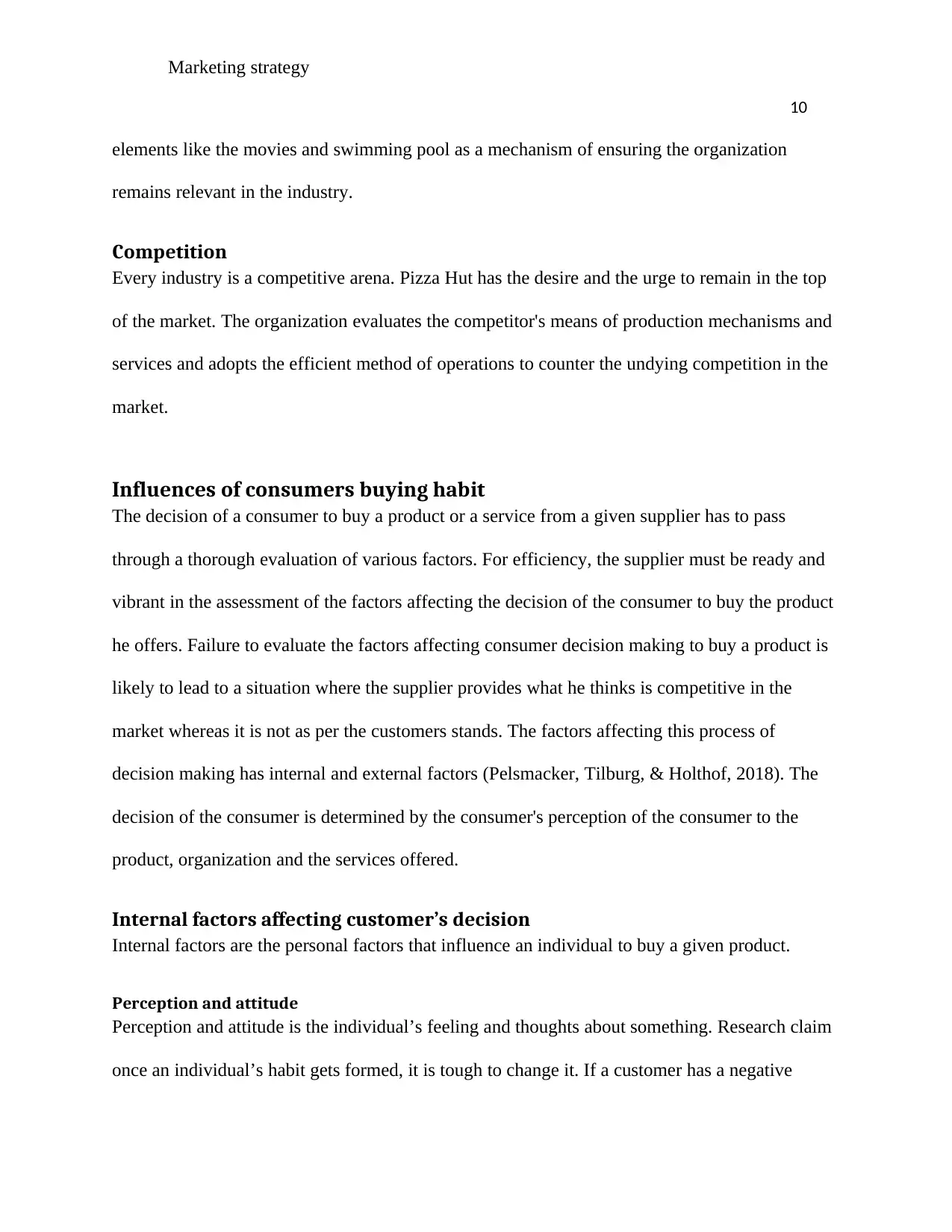
Marketing strategy
10
elements like the movies and swimming pool as a mechanism of ensuring the organization
remains relevant in the industry.
Competition
Every industry is a competitive arena. Pizza Hut has the desire and the urge to remain in the top
of the market. The organization evaluates the competitor's means of production mechanisms and
services and adopts the efficient method of operations to counter the undying competition in the
market.
Influences of consumers buying habit
The decision of a consumer to buy a product or a service from a given supplier has to pass
through a thorough evaluation of various factors. For efficiency, the supplier must be ready and
vibrant in the assessment of the factors affecting the decision of the consumer to buy the product
he offers. Failure to evaluate the factors affecting consumer decision making to buy a product is
likely to lead to a situation where the supplier provides what he thinks is competitive in the
market whereas it is not as per the customers stands. The factors affecting this process of
decision making has internal and external factors (Pelsmacker, Tilburg, & Holthof, 2018). The
decision of the consumer is determined by the consumer's perception of the consumer to the
product, organization and the services offered.
Internal factors affecting customer’s decision
Internal factors are the personal factors that influence an individual to buy a given product.
Perception and attitude
Perception and attitude is the individual’s feeling and thoughts about something. Research claim
once an individual’s habit gets formed, it is tough to change it. If a customer has a negative
10
elements like the movies and swimming pool as a mechanism of ensuring the organization
remains relevant in the industry.
Competition
Every industry is a competitive arena. Pizza Hut has the desire and the urge to remain in the top
of the market. The organization evaluates the competitor's means of production mechanisms and
services and adopts the efficient method of operations to counter the undying competition in the
market.
Influences of consumers buying habit
The decision of a consumer to buy a product or a service from a given supplier has to pass
through a thorough evaluation of various factors. For efficiency, the supplier must be ready and
vibrant in the assessment of the factors affecting the decision of the consumer to buy the product
he offers. Failure to evaluate the factors affecting consumer decision making to buy a product is
likely to lead to a situation where the supplier provides what he thinks is competitive in the
market whereas it is not as per the customers stands. The factors affecting this process of
decision making has internal and external factors (Pelsmacker, Tilburg, & Holthof, 2018). The
decision of the consumer is determined by the consumer's perception of the consumer to the
product, organization and the services offered.
Internal factors affecting customer’s decision
Internal factors are the personal factors that influence an individual to buy a given product.
Perception and attitude
Perception and attitude is the individual’s feeling and thoughts about something. Research claim
once an individual’s habit gets formed, it is tough to change it. If a customer has a negative
Paraphrase This Document
Need a fresh take? Get an instant paraphrase of this document with our AI Paraphraser
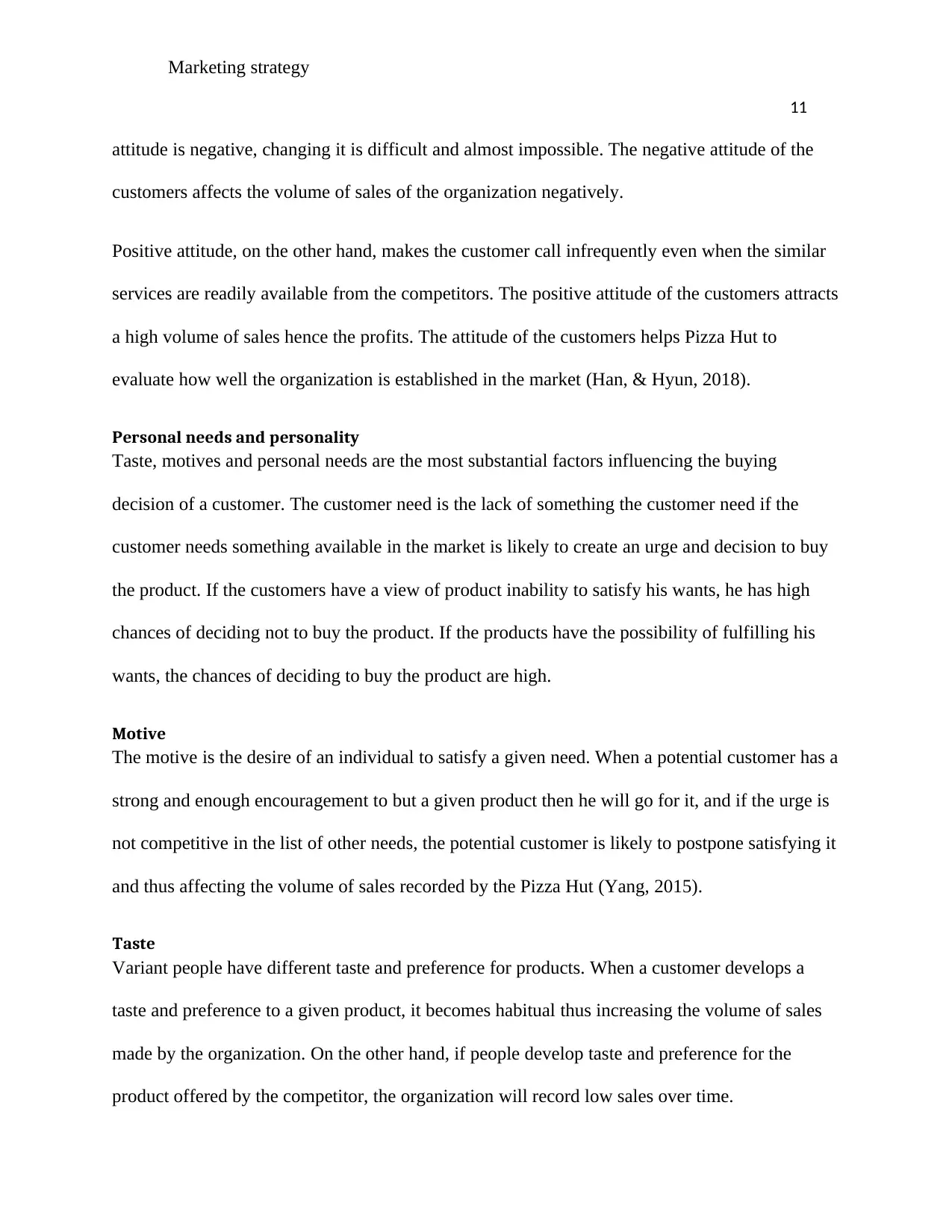
Marketing strategy
11
attitude is negative, changing it is difficult and almost impossible. The negative attitude of the
customers affects the volume of sales of the organization negatively.
Positive attitude, on the other hand, makes the customer call infrequently even when the similar
services are readily available from the competitors. The positive attitude of the customers attracts
a high volume of sales hence the profits. The attitude of the customers helps Pizza Hut to
evaluate how well the organization is established in the market (Han, & Hyun, 2018).
Personal needs and personality
Taste, motives and personal needs are the most substantial factors influencing the buying
decision of a customer. The customer need is the lack of something the customer need if the
customer needs something available in the market is likely to create an urge and decision to buy
the product. If the customers have a view of product inability to satisfy his wants, he has high
chances of deciding not to buy the product. If the products have the possibility of fulfilling his
wants, the chances of deciding to buy the product are high.
Motive
The motive is the desire of an individual to satisfy a given need. When a potential customer has a
strong and enough encouragement to but a given product then he will go for it, and if the urge is
not competitive in the list of other needs, the potential customer is likely to postpone satisfying it
and thus affecting the volume of sales recorded by the Pizza Hut (Yang, 2015).
Taste
Variant people have different taste and preference for products. When a customer develops a
taste and preference to a given product, it becomes habitual thus increasing the volume of sales
made by the organization. On the other hand, if people develop taste and preference for the
product offered by the competitor, the organization will record low sales over time.
11
attitude is negative, changing it is difficult and almost impossible. The negative attitude of the
customers affects the volume of sales of the organization negatively.
Positive attitude, on the other hand, makes the customer call infrequently even when the similar
services are readily available from the competitors. The positive attitude of the customers attracts
a high volume of sales hence the profits. The attitude of the customers helps Pizza Hut to
evaluate how well the organization is established in the market (Han, & Hyun, 2018).
Personal needs and personality
Taste, motives and personal needs are the most substantial factors influencing the buying
decision of a customer. The customer need is the lack of something the customer need if the
customer needs something available in the market is likely to create an urge and decision to buy
the product. If the customers have a view of product inability to satisfy his wants, he has high
chances of deciding not to buy the product. If the products have the possibility of fulfilling his
wants, the chances of deciding to buy the product are high.
Motive
The motive is the desire of an individual to satisfy a given need. When a potential customer has a
strong and enough encouragement to but a given product then he will go for it, and if the urge is
not competitive in the list of other needs, the potential customer is likely to postpone satisfying it
and thus affecting the volume of sales recorded by the Pizza Hut (Yang, 2015).
Taste
Variant people have different taste and preference for products. When a customer develops a
taste and preference to a given product, it becomes habitual thus increasing the volume of sales
made by the organization. On the other hand, if people develop taste and preference for the
product offered by the competitor, the organization will record low sales over time.
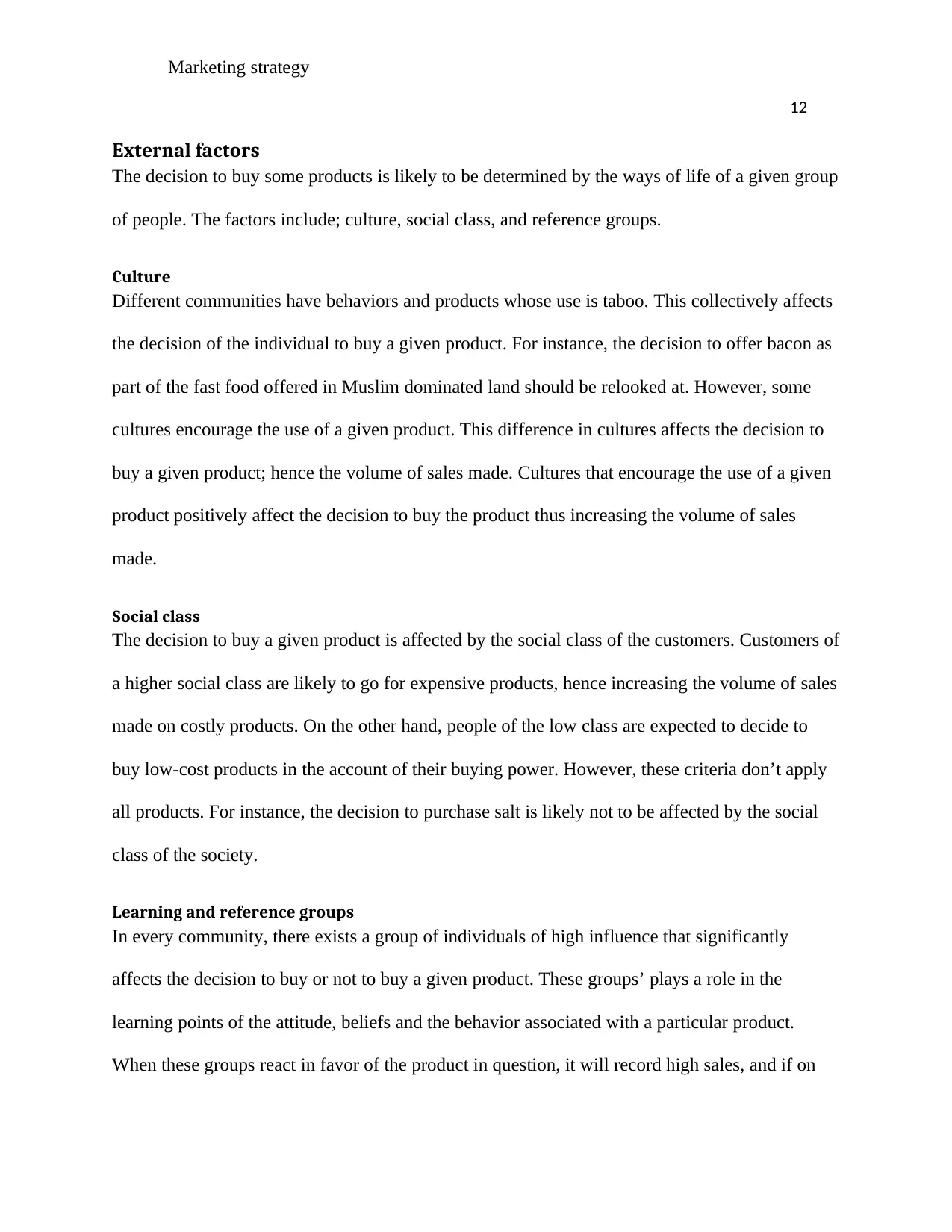
Marketing strategy
12
External factors
The decision to buy some products is likely to be determined by the ways of life of a given group
of people. The factors include; culture, social class, and reference groups.
Culture
Different communities have behaviors and products whose use is taboo. This collectively affects
the decision of the individual to buy a given product. For instance, the decision to offer bacon as
part of the fast food offered in Muslim dominated land should be relooked at. However, some
cultures encourage the use of a given product. This difference in cultures affects the decision to
buy a given product; hence the volume of sales made. Cultures that encourage the use of a given
product positively affect the decision to buy the product thus increasing the volume of sales
made.
Social class
The decision to buy a given product is affected by the social class of the customers. Customers of
a higher social class are likely to go for expensive products, hence increasing the volume of sales
made on costly products. On the other hand, people of the low class are expected to decide to
buy low-cost products in the account of their buying power. However, these criteria don’t apply
all products. For instance, the decision to purchase salt is likely not to be affected by the social
class of the society.
Learning and reference groups
In every community, there exists a group of individuals of high influence that significantly
affects the decision to buy or not to buy a given product. These groups’ plays a role in the
learning points of the attitude, beliefs and the behavior associated with a particular product.
When these groups react in favor of the product in question, it will record high sales, and if on
12
External factors
The decision to buy some products is likely to be determined by the ways of life of a given group
of people. The factors include; culture, social class, and reference groups.
Culture
Different communities have behaviors and products whose use is taboo. This collectively affects
the decision of the individual to buy a given product. For instance, the decision to offer bacon as
part of the fast food offered in Muslim dominated land should be relooked at. However, some
cultures encourage the use of a given product. This difference in cultures affects the decision to
buy a given product; hence the volume of sales made. Cultures that encourage the use of a given
product positively affect the decision to buy the product thus increasing the volume of sales
made.
Social class
The decision to buy a given product is affected by the social class of the customers. Customers of
a higher social class are likely to go for expensive products, hence increasing the volume of sales
made on costly products. On the other hand, people of the low class are expected to decide to
buy low-cost products in the account of their buying power. However, these criteria don’t apply
all products. For instance, the decision to purchase salt is likely not to be affected by the social
class of the society.
Learning and reference groups
In every community, there exists a group of individuals of high influence that significantly
affects the decision to buy or not to buy a given product. These groups’ plays a role in the
learning points of the attitude, beliefs and the behavior associated with a particular product.
When these groups react in favor of the product in question, it will record high sales, and if on
⊘ This is a preview!⊘
Do you want full access?
Subscribe today to unlock all pages.

Trusted by 1+ million students worldwide
1 out of 20
Related Documents
Your All-in-One AI-Powered Toolkit for Academic Success.
+13062052269
info@desklib.com
Available 24*7 on WhatsApp / Email
![[object Object]](/_next/static/media/star-bottom.7253800d.svg)
Unlock your academic potential
Copyright © 2020–2025 A2Z Services. All Rights Reserved. Developed and managed by ZUCOL.





